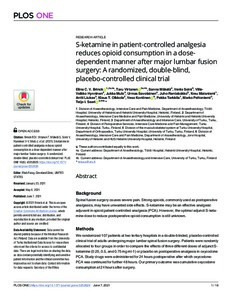S-ketamine in patient-controlled analgesia reduces opioid consumption in a dose-dependent manner after major lumbar fusion surgery: A randomized, double-blind, placebo-controlled clinical trial
Brinck Elina CV; Virtanen Taru; Mäkelä Sanna; Soini Venla; Hynninen Veikko V; Mulo Jukka; Savolainen Urmas; Rantakokko Juho; Maisniemi Kreu; Liukas Antti; Olkkola Klaus T; Kontinen Vesa; Tarkkila Pekka; Peltoniemi Marko; Saari Teijo I
S-ketamine in patient-controlled analgesia reduces opioid consumption in a dose-dependent manner after major lumbar fusion surgery: A randomized, double-blind, placebo-controlled clinical trial
Brinck Elina CV
Virtanen Taru
Mäkelä Sanna
Soini Venla
Hynninen Veikko V
Mulo Jukka
Savolainen Urmas
Rantakokko Juho
Maisniemi Kreu
Liukas Antti
Olkkola Klaus T
Kontinen Vesa
Tarkkila Pekka
Peltoniemi Marko
Saari Teijo I
PUBLIC LIBRARY SCIENCE
Julkaisun pysyvä osoite on:
https://urn.fi/URN:NBN:fi-fe2021093047959
https://urn.fi/URN:NBN:fi-fe2021093047959
Tiivistelmä
Background Spinal fusion surgery causes severe pain. Strong opioids, commonly used as postoperative analgesics, may have unwanted side effects. S-ketamine may be an effective analgesic adjuvant in opioid patient-controlled analgesia (PCA). However, the optimal adjunct S-ketamine dose to reduce postoperative opioid consumption is still unknown.Methods We randomized 107 patients at two tertiary hospitals in a double-blinded, placebo-controlled clinical trial of adults undergoing major lumbar spinal fusion surgery. Patients were randomly allocated to four groups in order to compare the effects of three different doses of adjunct S-ketamine (0.25, 0.5, and 0.75 mg ml-1) or placebo on postoperative analgesia in oxycodone PCA. Study drugs were administered for 24 hours postoperative after which oxycodone-PCA was continued for further 48 hours. Our primary outcome was cumulative oxycodone consumption at 24 hours after surgery.Results Of the 100 patients analyzed, patients receiving 0.75 mg ml(-1) S-ketamine in oxycodone PCA needed 25% less oxycodone at 24 h postoperatively (61.2 mg) compared with patients receiving 0.5 mg ml(-1) (74.7 mg) or 0.25 mg ml(-1) (74.1 mg) S-ketamine in oxycodone or oxycodone alone (81.9 mg) (mean difference: -20.6 mg; 95% confidence interval [CI]: -41 to -0.20; P = 0.048). A beneficial effect in mean change of pain intensity at rest was seen in the group receiving 0.75 mg ml(-1) S-ketamine in oxycodone PCA compared with patients receiving lower ketamine doses or oxycodone alone (standardized effect size: 0.17, 95% CI: 0.013-0.32, P = 0.033). The occurrence of adverse events was similar among the groups.Conclusions Oxycodone PCA containing S-ketamine as an adjunct at a ratio of 1: 0.75 decreased cumulative oxycodone consumption at 24 h after major lumbar spinal fusion surgery without additional adverse effects.
Kokoelmat
- Rinnakkaistallenteet [27094]
